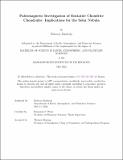Paleomagnetic Investigation of Enstatite Chondrite Chondrules: Implications for the Solar Nebula
Author(s)
Mastrola, Becca
DownloadThesis PDF (2.849Mb)
Advisor
Weiss, Benjamin P.
Terms of use
Metadata
Show full item recordAbstract
The early stages of solar system formation were characterized by the rapid evolution of the protoplanetary disk. A magnetic field governed the highly efficient mass and angular momentum transport systems. Paleomagnetic measurements of chondrites have constrained the intensity of the nebular field between ∼3-7 AU. Previous work on two dusty olivine chondrules from high iron enstatite chondrites with variable kamacite grain sizes implied strong inner nebular field (∼1-2 AU) intensities of 185 ± 111 µT and 299 ± 247 µT. One new dusty olivine chondrule, containing exclusively submicron kamacite grains, suggested an inner nebular field intensity of 15.2 ± 12.4 µT. The wide field strength error margins and seemingly low-coercivity grains limit the reliability of calculated paleointensities from these chondrules. Thus, the paleointensity of the inner nebular field cannot be definitively constrained by the magnetizations of the dusty olivine chondrules.
Date issued
2024-05Department
Massachusetts Institute of Technology. Department of Earth, Atmospheric, and Planetary SciencesPublisher
Massachusetts Institute of Technology